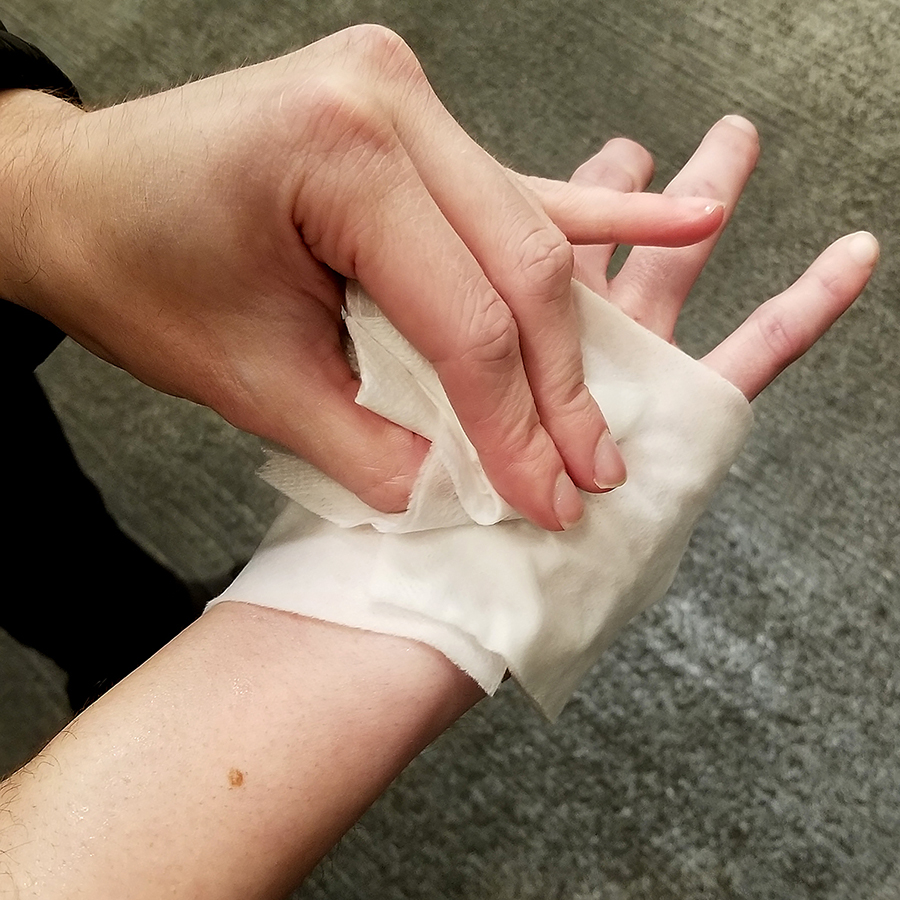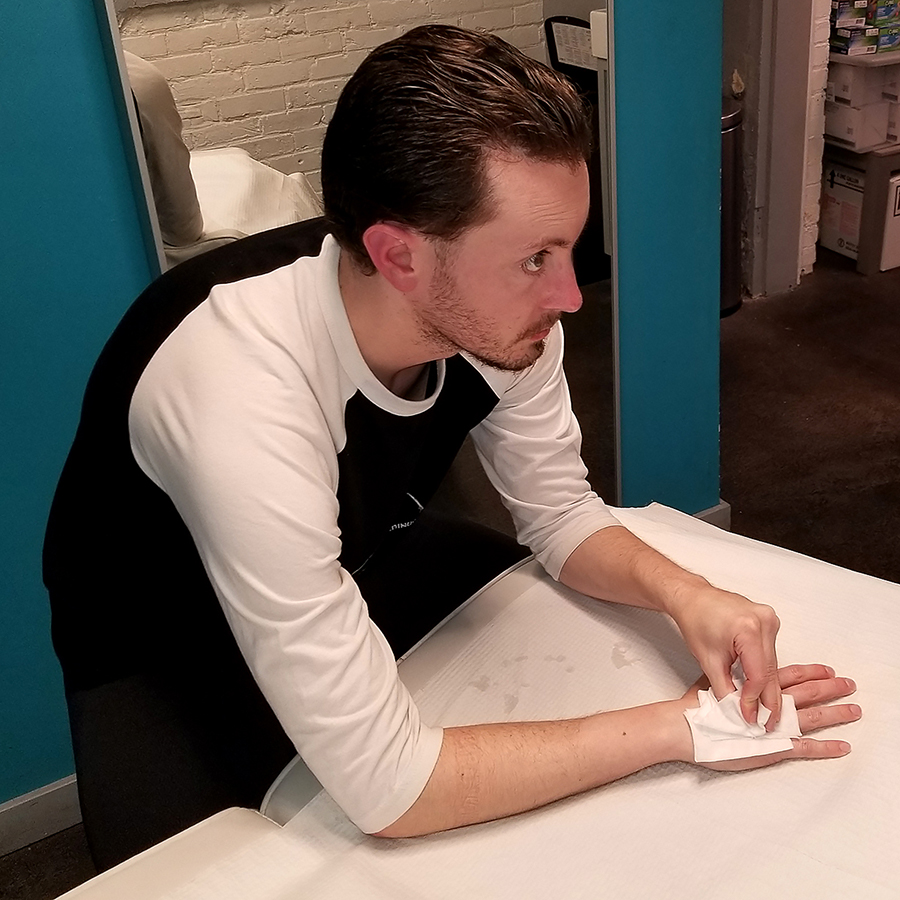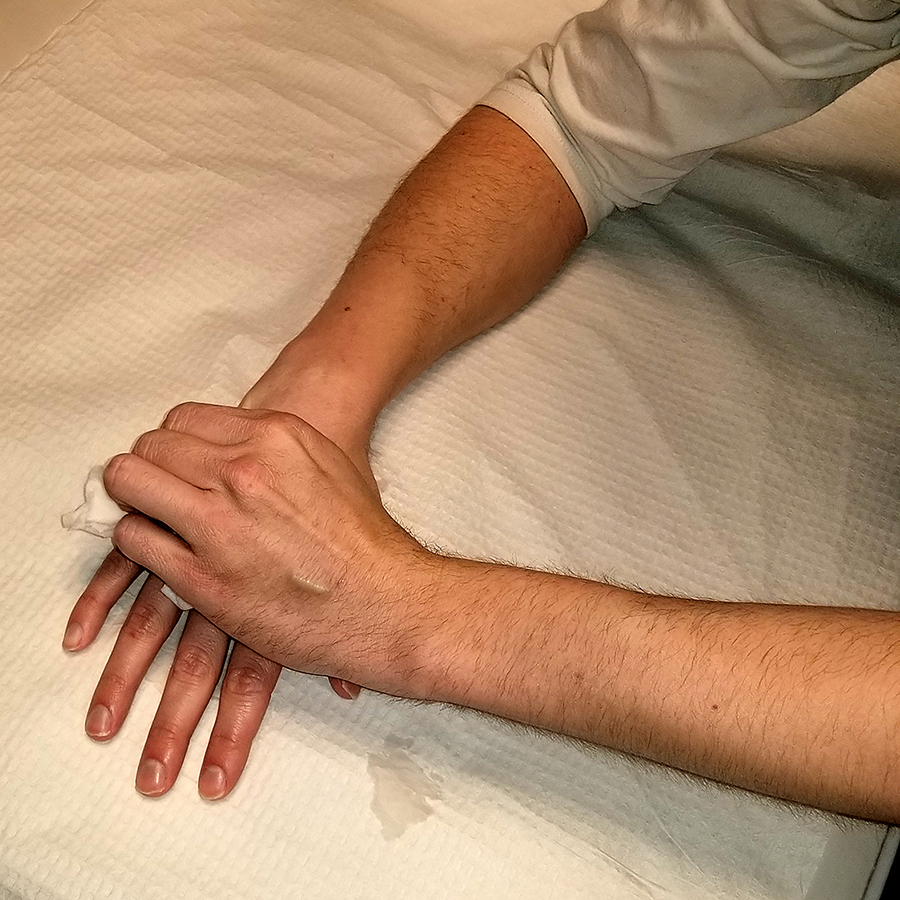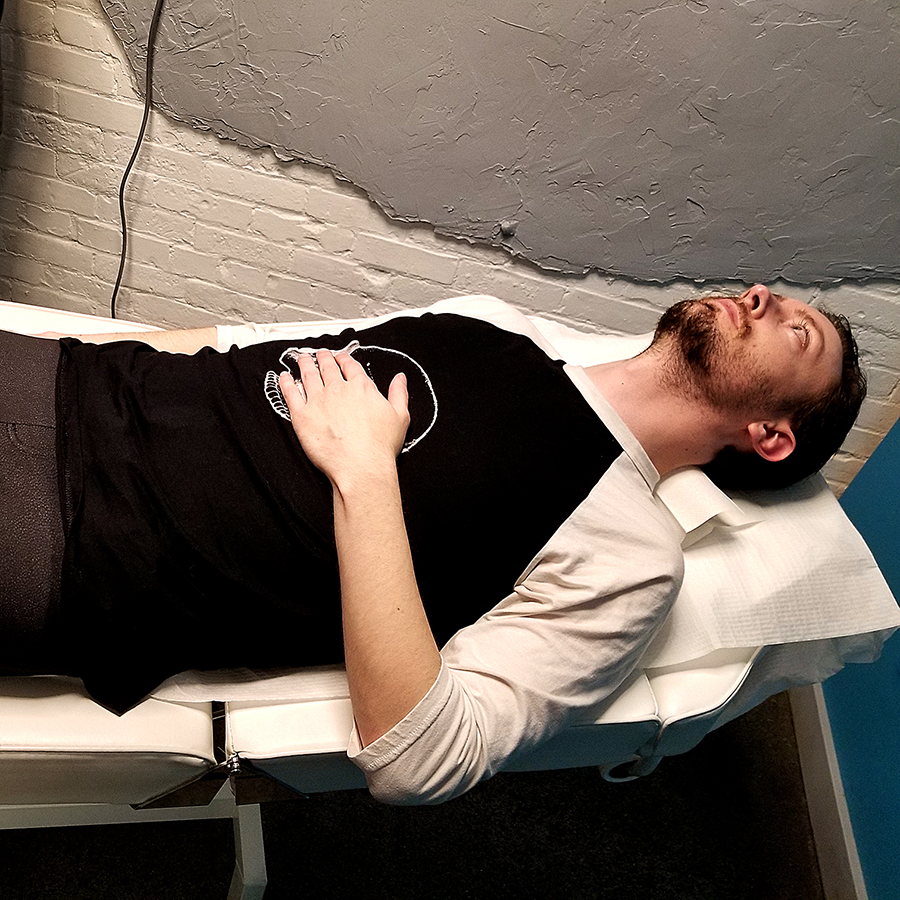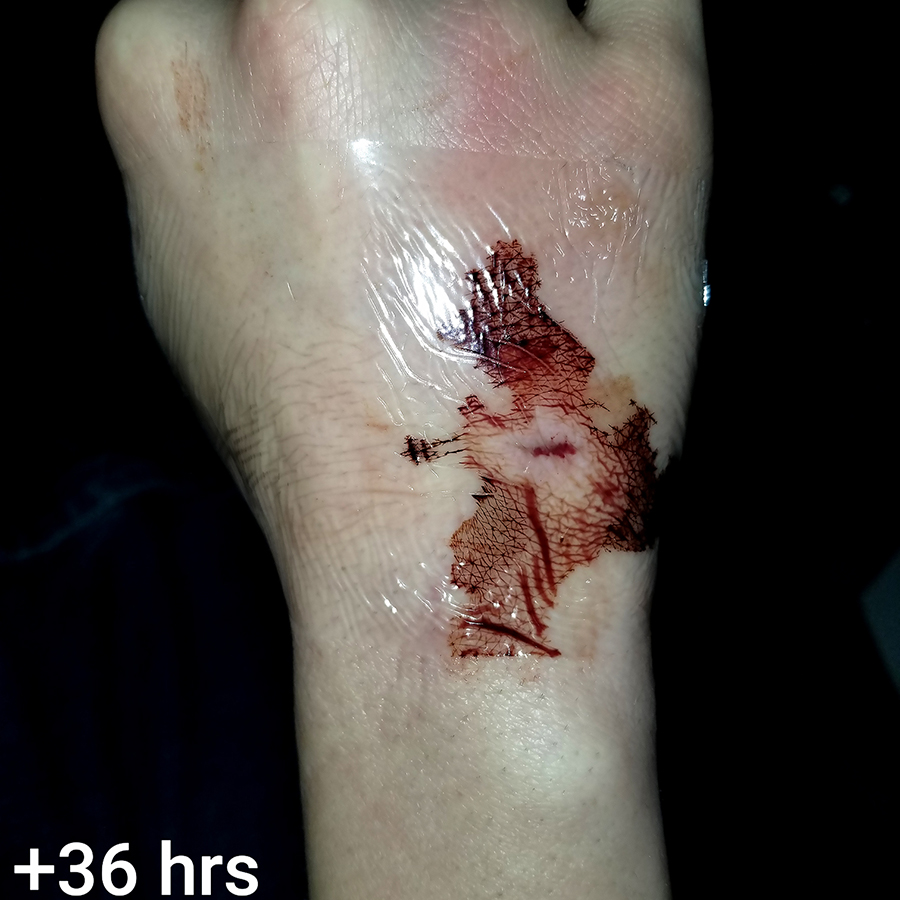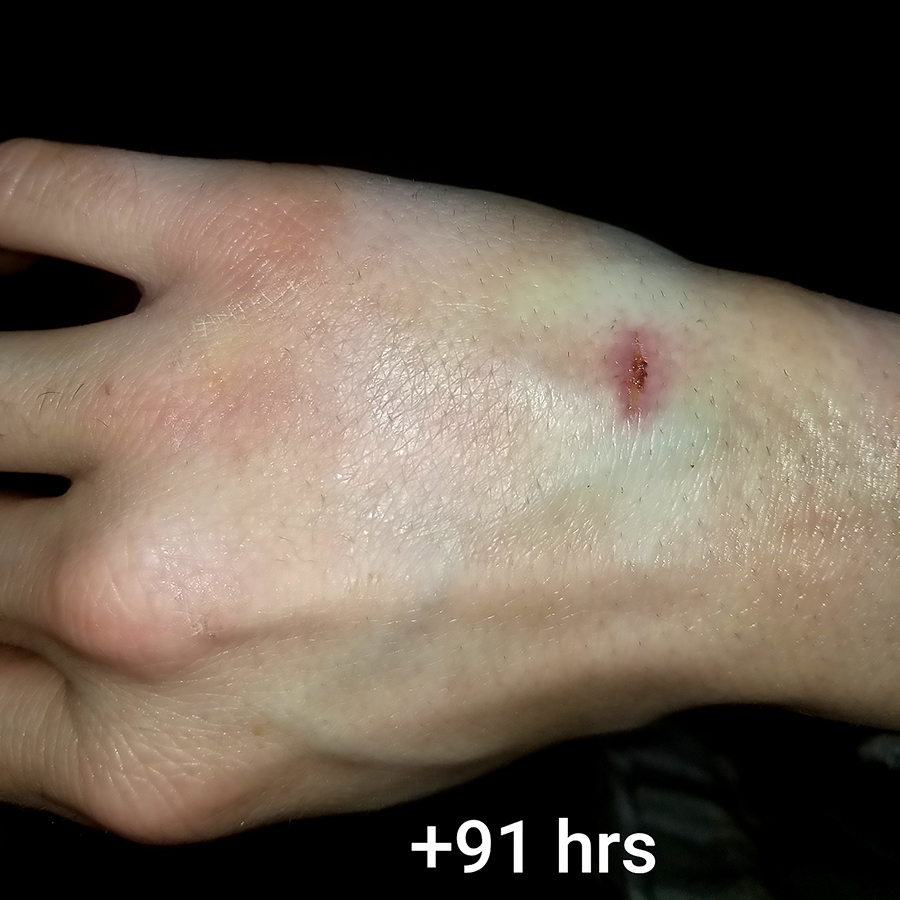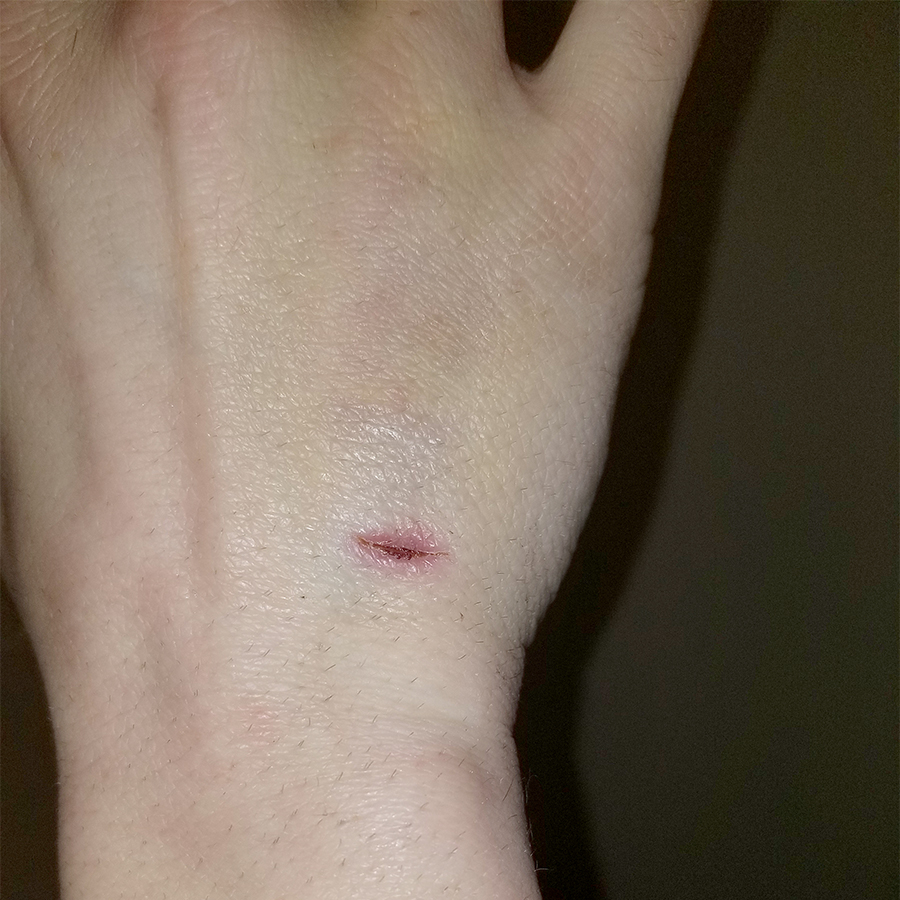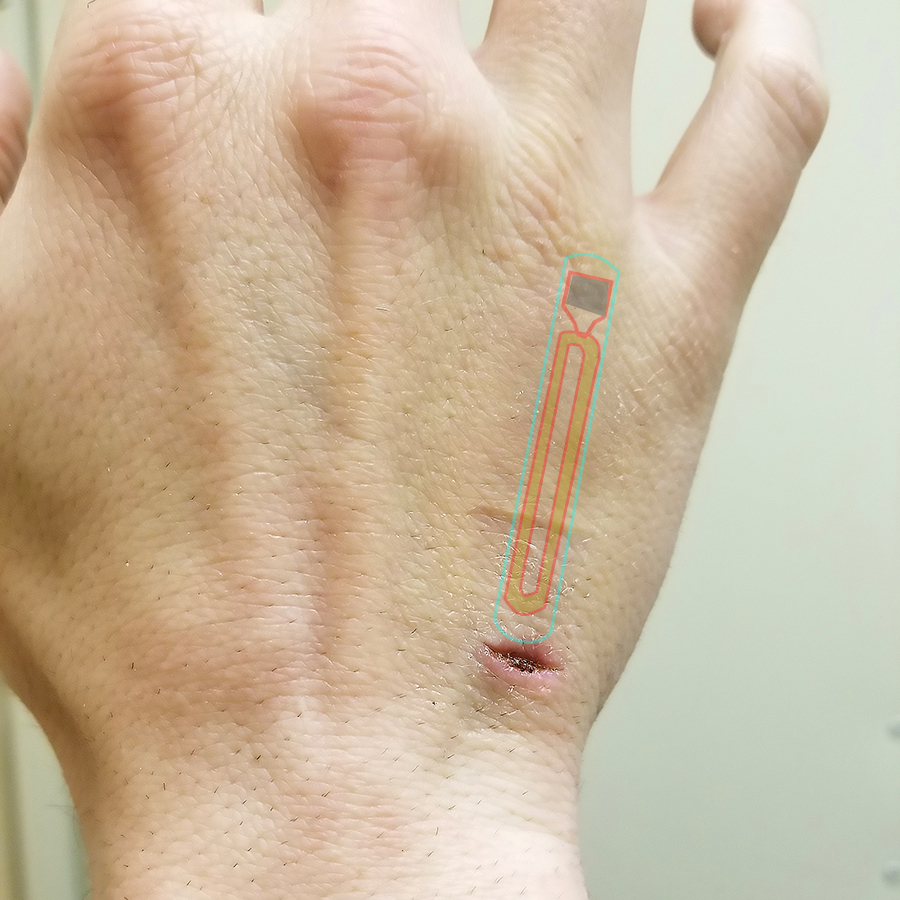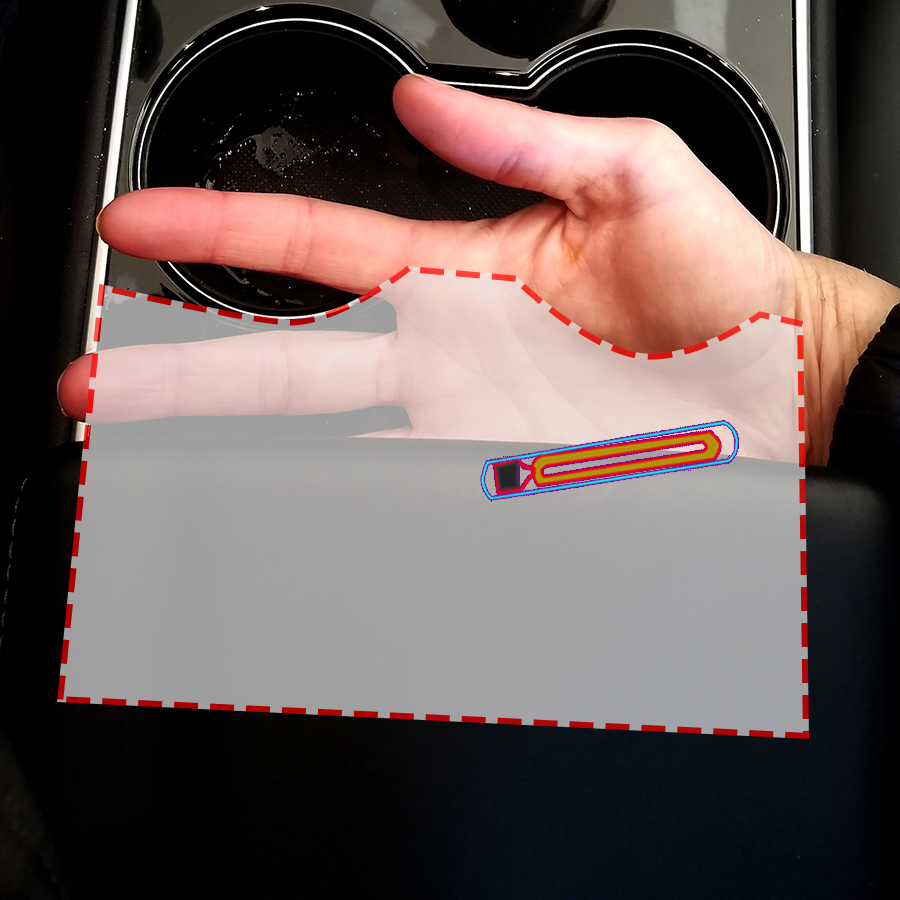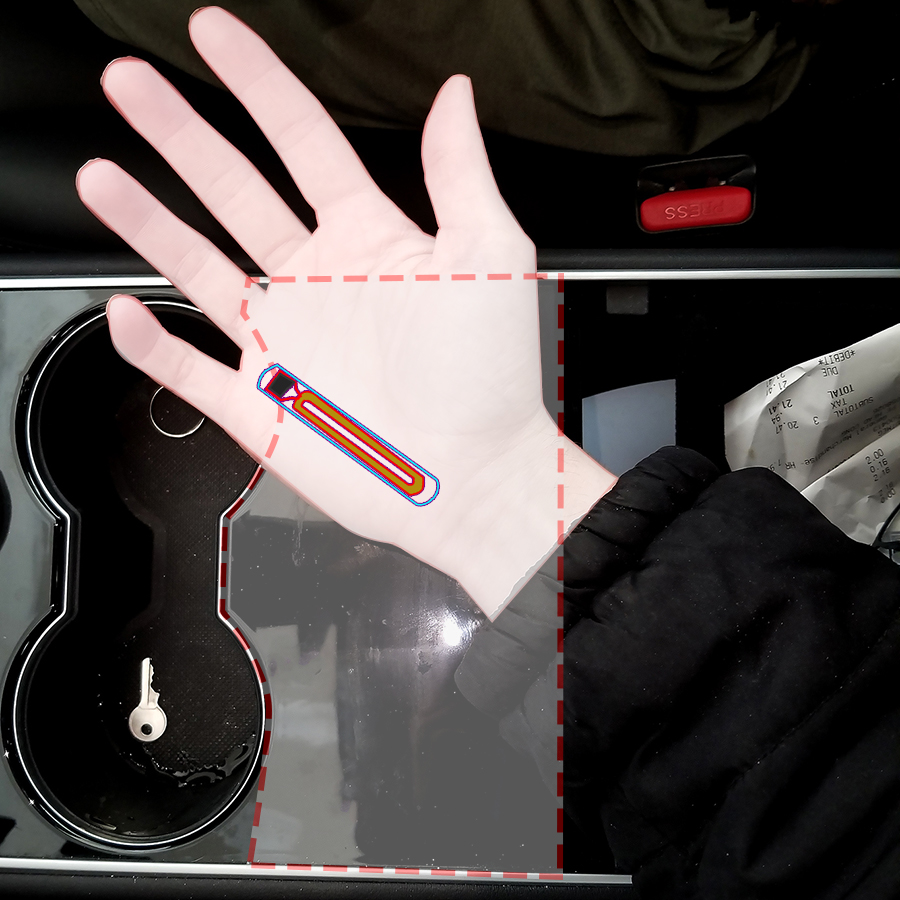
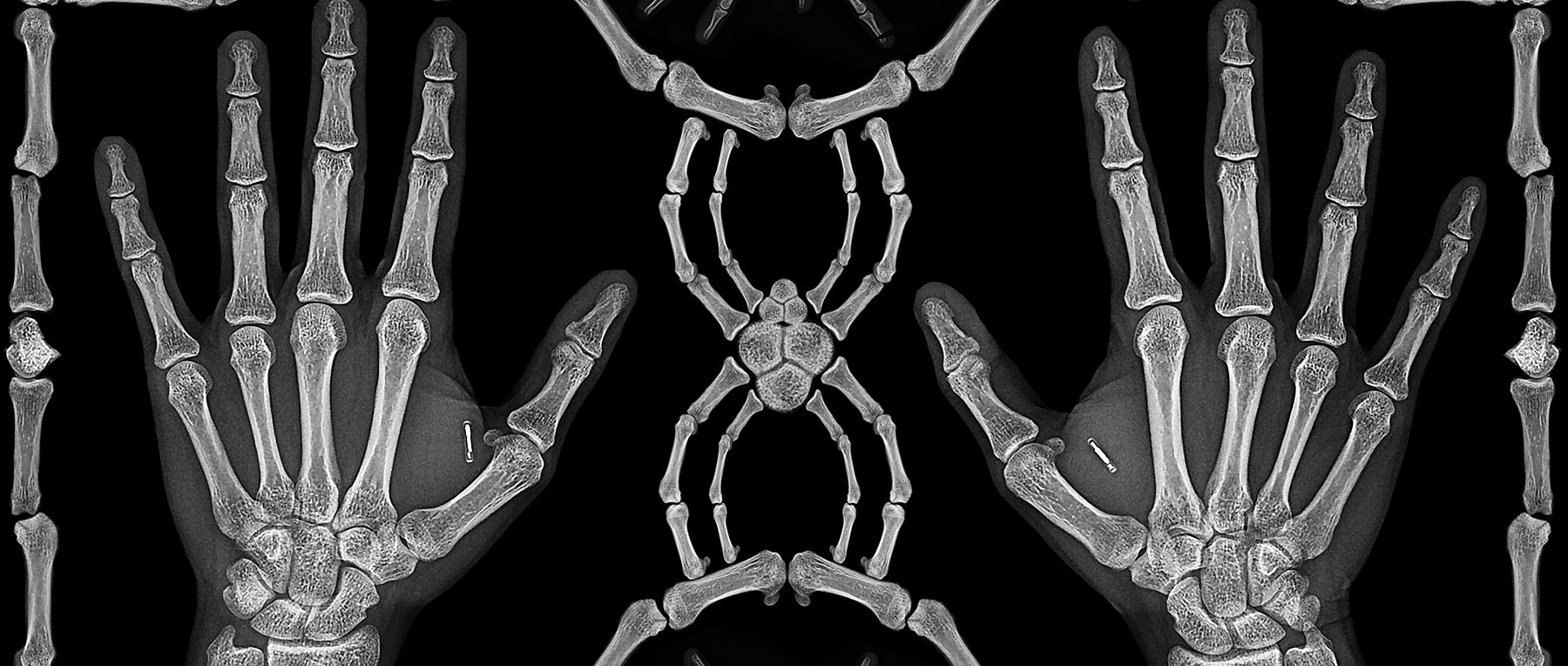
Cybernetic Implants:
So far I have had four pieces of tech implanted under my skin. These are a xEM RFID tag in my right hand, a xNT NFC tag in my left hand, a xG3 magnet in my left hand, and a 'TeslaFlex' FlexKey in my right hand. Click on the tabs to learn more about each implant, my stories behind their implantation, and to see pictures/videos of them being inserted. I also have some videos of them in action.
xEM RFID
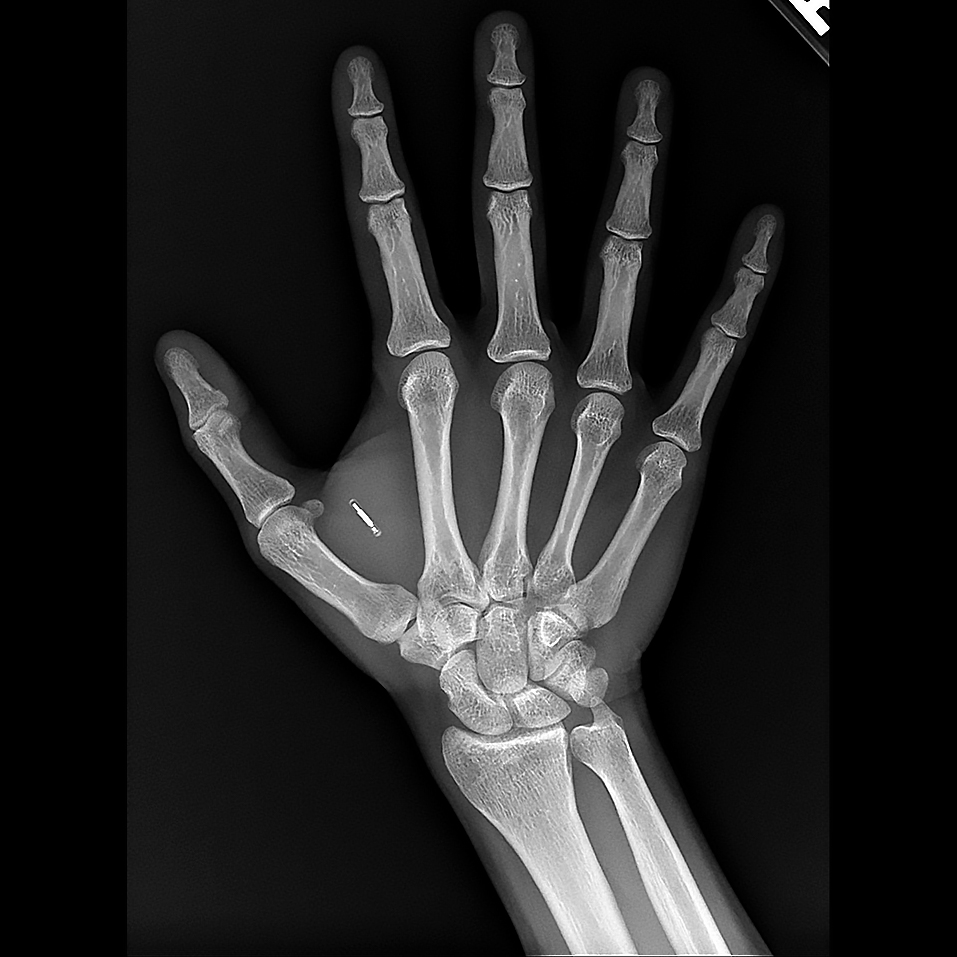 In mid-2018 I purchased two implantable tags: the xEM RFID tag and the xNT NFC tag. The xEM is a low-frequency passive RFID tag capable of storing only a few bytes of information. I tried for a few weeks to find a professional to install these. Doctors, veterinarians, and even some piercing/tattoo studios would not do the implant for me. Eventually I gave up and asked my cousin if he would be willing to do this. He was a phlebotomist in the past and felt relatively comfortable with the insertion process.
In mid-2018 I purchased two implantable tags: the xEM RFID tag and the xNT NFC tag. The xEM is a low-frequency passive RFID tag capable of storing only a few bytes of information. I tried for a few weeks to find a professional to install these. Doctors, veterinarians, and even some piercing/tattoo studios would not do the implant for me. Eventually I gave up and asked my cousin if he would be willing to do this. He was a phlebotomist in the past and felt relatively comfortable with the insertion process.
I purchased these from DangerousThings, a company that manufactures implantable technology. Dangerous Things was founded by Amal Graafstra, a pioneer and transhumanist, who works daily in the labs to advance the field of biotech. All of my future implants have also been manufactured by Dangerous Things.
The process was relatively simple: sanitize the tools and hands, open the sterile packaging to create the staging area, glove up, pull the skin upwards, massage and pull to separate the underlying layers, insert the needle tip bevel sided down midway between thumb and forefinger, keep needle parallel with metacarpal bones, insert to a decent depth, retract a few millimeters, then deposit the tag. Apply pressure while pulling the needle out, maintain light pressure for a few minutes.
This was the second insertion of that night. The first was the NFC tag. We did not perform the first insertion optimally, with the tag ending up in the muscle tissue. This insertion went relatively flawlessly. Video of the insertion to the right:
I have since programmed this tag to emulate my work ID. The physical security devices at work all respond well with this tag – often times responding without me even needing to contact the reader. I’ve used this for comedic effect; pretending that a banana is our server room key and other silly things like that.
xNT NFC
 In mid-2018 I purchased two implantable tags: the xEM RFID tag and the xNT NFC tag. The xNT is a 13.56 MHz ISO14443A NFC Type 2 tag capable of storing 886 bytes of memory. I tried for a few weeks to find a professional to install these. Doctors, veterinarians, and even some piercing/tattoo studios would not do the implant for me. Eventually I gave up and asked my cousin if he would be willing to do this. He was a phlebotomist in the past and felt relatively comfortable with the insertion process.
In mid-2018 I purchased two implantable tags: the xEM RFID tag and the xNT NFC tag. The xNT is a 13.56 MHz ISO14443A NFC Type 2 tag capable of storing 886 bytes of memory. I tried for a few weeks to find a professional to install these. Doctors, veterinarians, and even some piercing/tattoo studios would not do the implant for me. Eventually I gave up and asked my cousin if he would be willing to do this. He was a phlebotomist in the past and felt relatively comfortable with the insertion process.
I purchased these from DangerousThings, a company that manufactures implantable technology. Dangerous Things was founded by Amal Graafstra, a pioneer and transhumanist, who works daily in the labs to advance the field of biotech. All of my future implants have also been manufactured by Dangerous Things.
The process was relatively simple: sanitize the tools and hands, open the sterile packaging to create the staging area, glove up, pull the skin upwards, massage and pull to separate the underlying layers, insert the needle tip bevel sided down midway between thumb and forefinger, keep needle parallel with metacarpal bones, insert to a decent depth, retract a few millimeters, then deposit the tag. Apply pressure while pulling the needle out, maintain light pressure for a few minutes.
This was the first insertion of that night. The second was the RFID tag. We did not perform this insertion optimally, with the tag ending up in the muscle tissue. The next insertion went relatively flawlessly. Video of the insertion to the right:
I have since programmed this tag for all kinds of uses. Rick-Rolling people, adding myself to someone's contact list, sending people to my personal website, setting up my hand as a computer access control. NFC is very easy to play with since all phones have the capability to read and write NFC devices. At SaintCon 2019 a panel was dedicated to the possibility of using implanted NFC for nefarious purposes. Setting up a hook on a website, and then using the NFC chip to send mobile devices to said website was the most successful of the black-hat possibilities.
xG3 Magnet
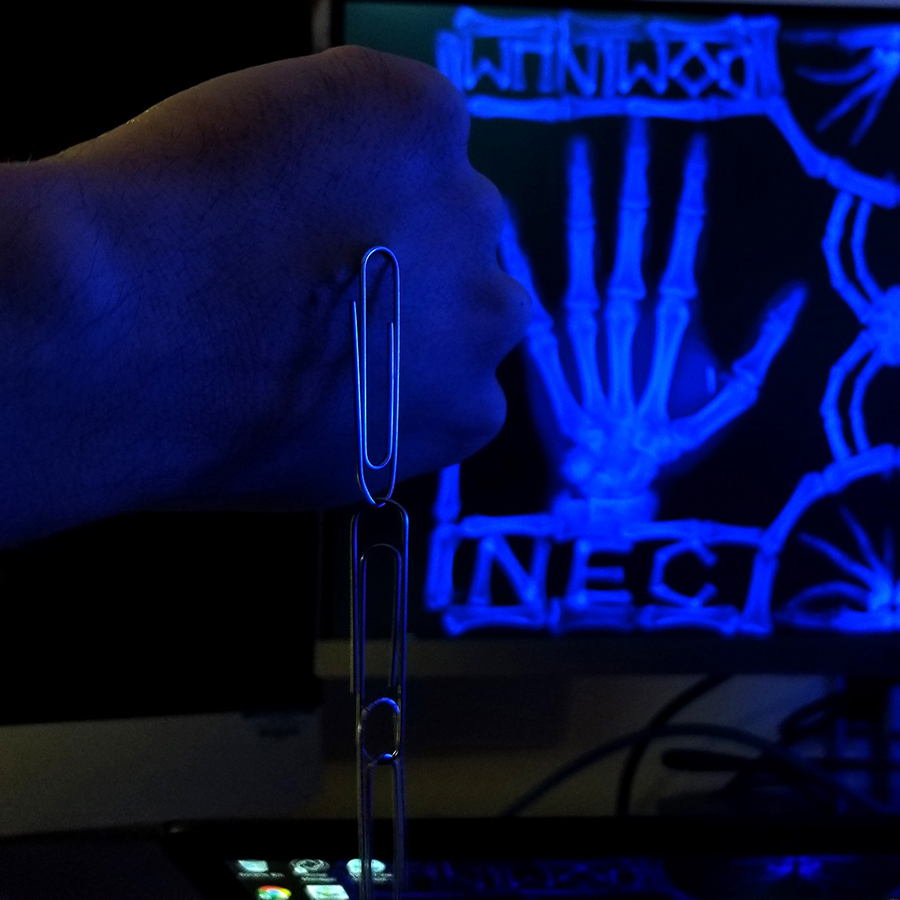 At SaintCon 2019 I purchased the xG3 Injectable Biomagnet, and had it implanted on the spot by the talented staff. This magnet is the world's first injectable and clinically sterilized biomagnet. The magnet provides decent lifting capabilities and holds onto flat metal objects very well. The size was bigger than I had expected; it is quite a bit thicker than my xNT and xEM. Those two hide well in my hand's skin, but the xG3 stands out.
At SaintCon 2019 I purchased the xG3 Injectable Biomagnet, and had it implanted on the spot by the talented staff. This magnet is the world's first injectable and clinically sterilized biomagnet. The magnet provides decent lifting capabilities and holds onto flat metal objects very well. The size was bigger than I had expected; it is quite a bit thicker than my xNT and xEM. Those two hide well in my hand's skin, but the xG3 stands out.
The xG3 can be purchased from DangerousThings, a company that manufactures implantable technology. Dangerous Things was founded by Amal Graafstra, a pioneer and transhumanist, who works daily in the labs to advance the field of biotech. All of my future implants have also been manufactured by Dangerous Things.
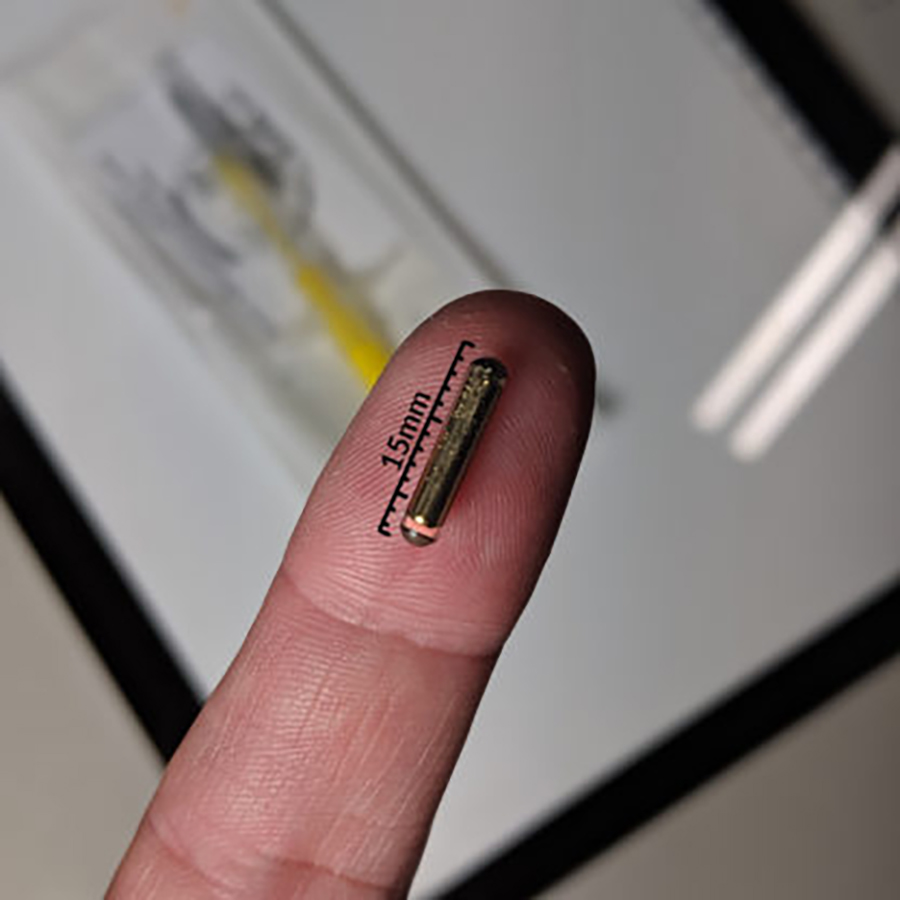 The insertion process on this is much the same as the xNT and xEM; The process was relatively simple: sanitize the tools and hands, open the sterile packaging to create the staging area, glove up, pull the skin upwards, massage and pull to separate the underlying layers, insert the needle tip bevel sided down, keep needle parallel with metacarpal bones, insert to a decent depth, retract a few millimeters, then deposit the tag. Apply pressure while pulling the needle out, maintain light pressure for a few minutes.
The insertion process on this is much the same as the xNT and xEM; The process was relatively simple: sanitize the tools and hands, open the sterile packaging to create the staging area, glove up, pull the skin upwards, massage and pull to separate the underlying layers, insert the needle tip bevel sided down, keep needle parallel with metacarpal bones, insert to a decent depth, retract a few millimeters, then deposit the tag. Apply pressure while pulling the needle out, maintain light pressure for a few minutes.
This was a bit of an impulse-buy while wandering the floor at SaintCon. As such, I do not have any documentation of the insertion procedure but I can describe it. Compared to my first insertions done by my phlebotomist cousin, this insertion was extremely simple and easy. Our first insertions took almost 2 minutes from start to finish; this insertion took 15 seconds tops. Even though the 9 gauge needle was intimidating and much larger than those for the xNT or xEM, the pain was much less than I had expected.
Image to the right belongs to DangerousThings.
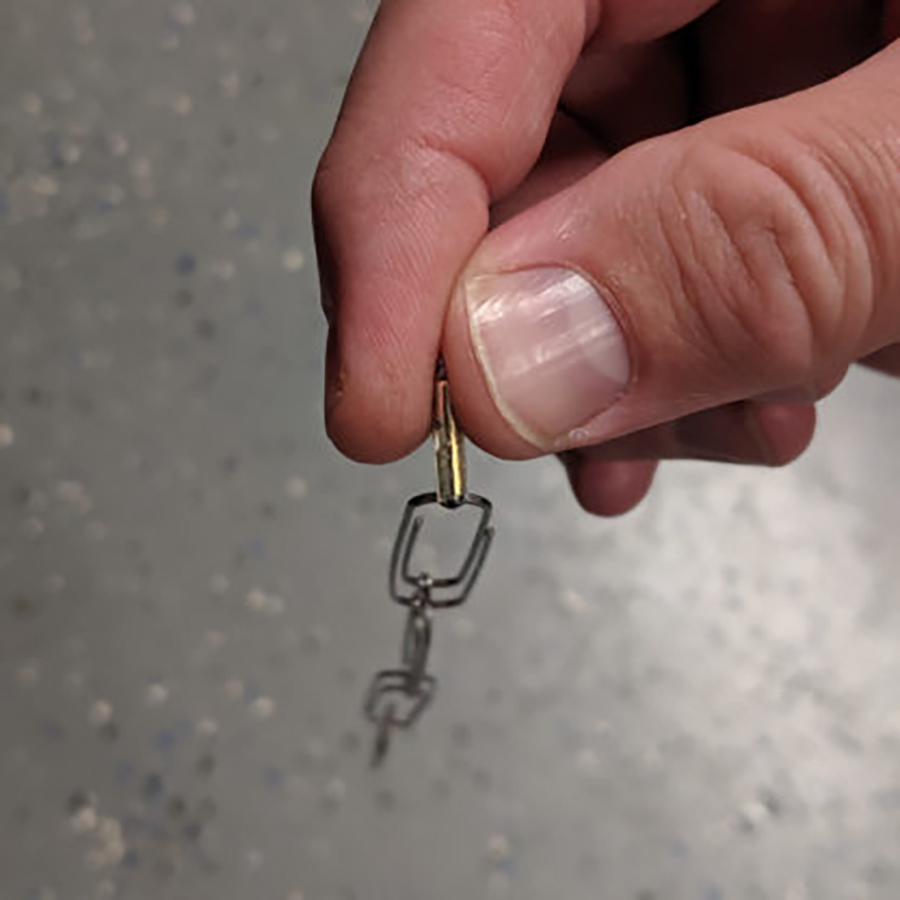 The xG3 is more of a novelty for me; I enjoy walking around with a key attached to my hand, or a chain of paperclips hanging off of it. During work meetings I will play with it by dangling a chain or some paperclips, moving them into the magnetic field until they are pulled and stop moving, then moving them away until the pull releases and the chain sways. I've had many people ask me about my implant after noticing these odd displays. I have yet to talk to someone who reacted negatively after I explained what it was.
The xG3 is more of a novelty for me; I enjoy walking around with a key attached to my hand, or a chain of paperclips hanging off of it. During work meetings I will play with it by dangling a chain or some paperclips, moving them into the magnetic field until they are pulled and stop moving, then moving them away until the pull releases and the chain sways. I've had many people ask me about my implant after noticing these odd displays. I have yet to talk to someone who reacted negatively after I explained what it was.
Image to the left belongs to DangerousThings.
Teslaflex
 After SaintCon 2019, where I discussed the newly released products from DT with many passionate people, I purchased the Teslaflex. The process of making this product is more involved than simply ordering the item and having it delivered to your house.
After SaintCon 2019, where I discussed the newly released products from DT with many passionate people, I purchased the Teslaflex. The process of making this product is more involved than simply ordering the item and having it delivered to your house.
My first step after purchasing was to contact Amal at Dangerous Things to verify the next steps. The Teslaflex is custom-made for each order, as it is made from the internal components of the Tesla valet KeyCard.
 The first step of the process is to take your valet keycard and send it over to Dangerous Things in Washington. Once the card makes it there, DT dissolves the plastics of the card using Acetate to retrieve the internal components without damaging them.
The first step of the process is to take your valet keycard and send it over to Dangerous Things in Washington. Once the card makes it there, DT dissolves the plastics of the card using Acetate to retrieve the internal components without damaging them.
I put the card and order confirmation into an envelope that night, sending it out the next morning.
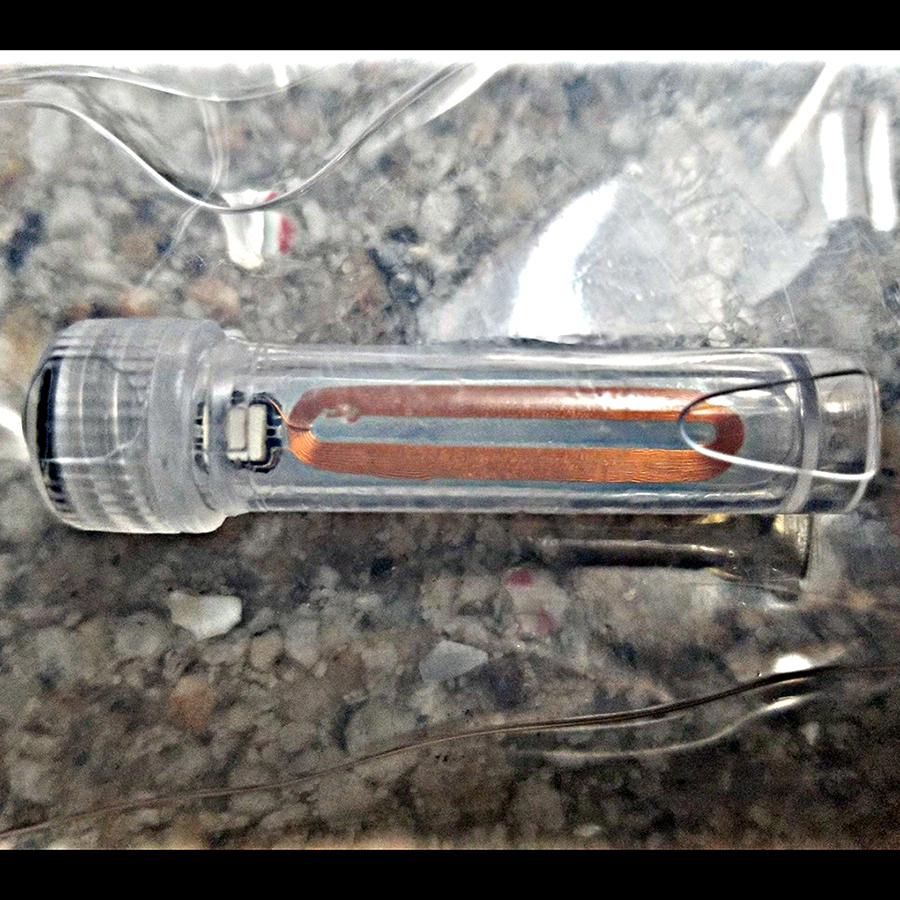 These are then organized neatly into a bio-implantable tag. DT mails the tag, which is inside of a sterile cylinder, which is also sealed in a sterile bag, suspended in fluid.
These are then organized neatly into a bio-implantable tag. DT mails the tag, which is inside of a sterile cylinder, which is also sealed in a sterile bag, suspended in fluid.
The tag is in a different form factor than the injectable tech; rather than a small bio-glass cylinder, these are flat, long, and decently wide devices that require some scalpel work (or 5mm wide piercing needle) in order to create the pocket that the key will slide into.
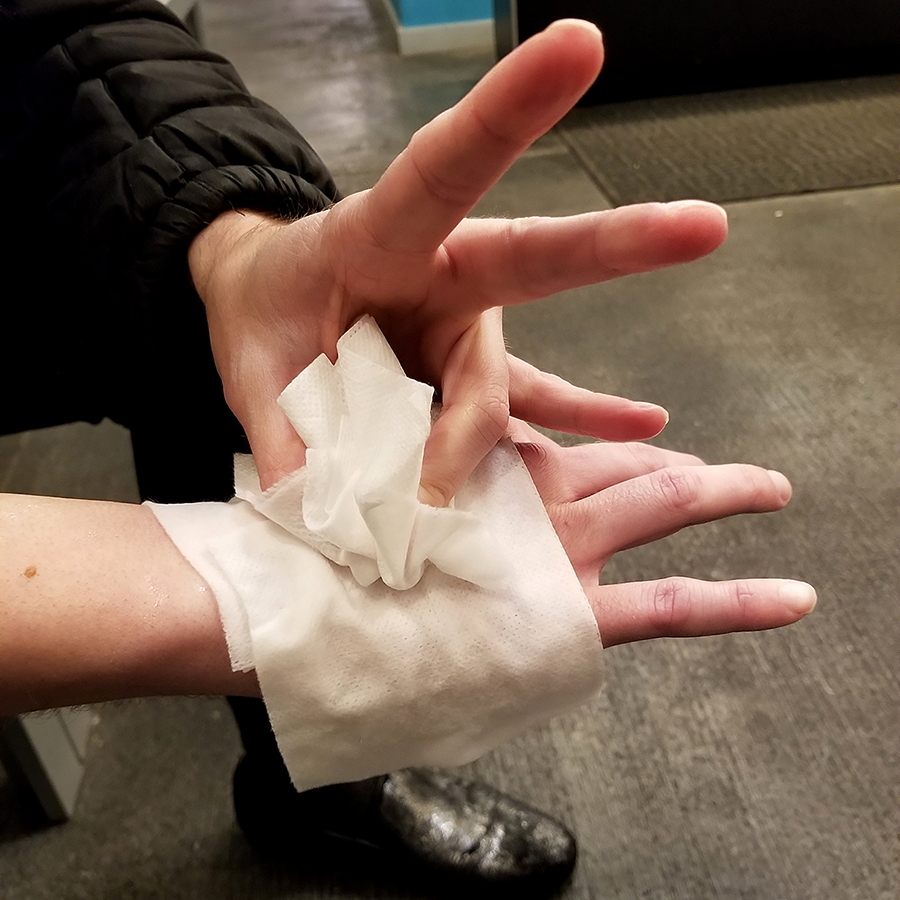 To get this done I went to Dustin Robbins of Enso Piercing and Adornment in SLC, UT. I went in on a Friday night as their last appointment at 7:30PM. When I arrived, I was asked to check in and sign the paperwork to have Dustin work on me.
To get this done I went to Dustin Robbins of Enso Piercing and Adornment in SLC, UT. I went in on a Friday night as their last appointment at 7:30PM. When I arrived, I was asked to check in and sign the paperwork to have Dustin work on me.
After checking in, Dustin came by with some Lidocaine soaked gauze which I was to hold against the surface of the skin for the next 30 or so minutes while he took care of the customers before me.
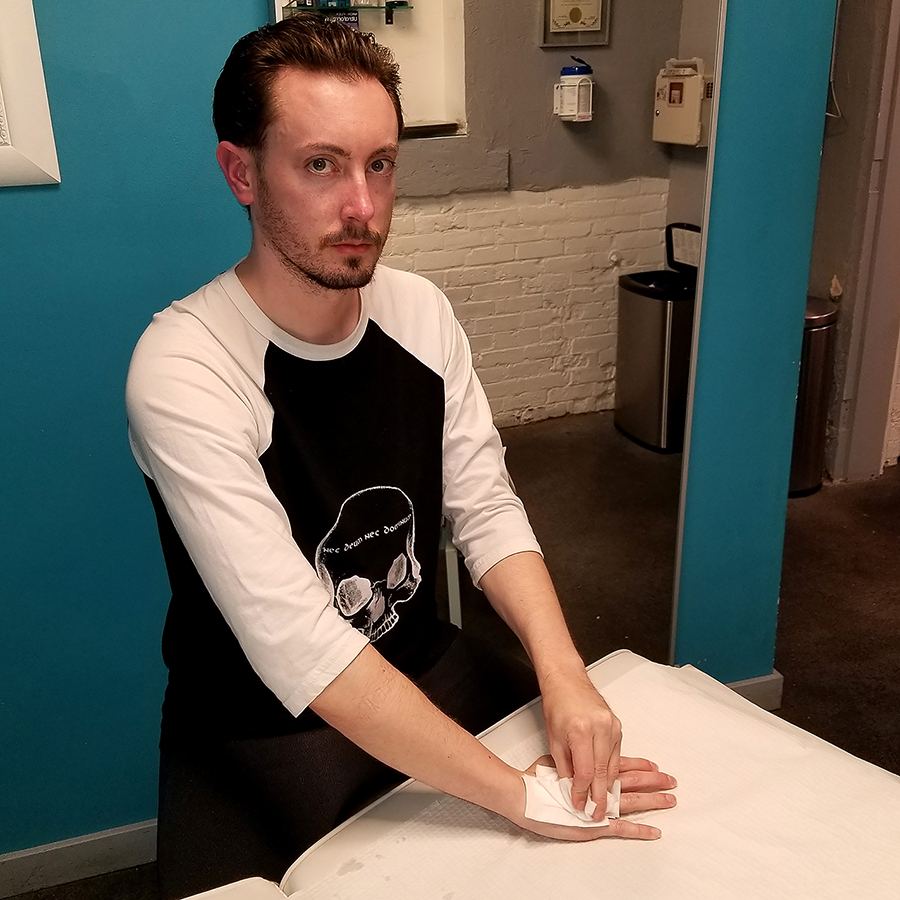 While waiting there were a few patrons and staff who were very interested in what I was about to have done. I let them know all about the tech, my previous implants, and the awesome things I have been able to do with them. They were all pretty excited to see my tech go in.
While waiting there were a few patrons and staff who were very interested in what I was about to have done. I let them know all about the tech, my previous implants, and the awesome things I have been able to do with them. They were all pretty excited to see my tech go in.
Dustin took me back to the piercing chair which we were going to use as a table since I had no intentions of laying down. D got all the tools sanitized, gloved up, laid out the staging area, and we began the implant process. My target location was the back of my right hand, on the surface above the pinky and ring finger’s metacarpals.
We went with the scalpel procedure, in which we make a 5mm wide incision using a scalpel and then open up a 35 mm deep pocket using a shim or elevator tool. This process was not nearly as painful as I was expecting. This was my first intensive implant and I didn’t really know what to expect. The scalpel cutting into the skin felt hot and was very reminiscent of dragging razors on my wrists.
In a way it was just nostalgic and made my stomach tingle. The shim being pushed under the skin was slightly nauseating and made the burning sensation intensify. At one point it slid forward pretty fast and interacted with my tendons in an odd way. It felt like my tendon was strummed like a guitar string; it vibrated for a bit and then went away. It wasn’t bad, just interesting.
 After the shim was pushed to the right depth, an assistant opened the vial containing the Teslaflex and dumped the contents onto a section of the sterile staging area. Dustin then picked the implant up and asked me if there was a specific orientation that it needed to go in.
After the shim was pushed to the right depth, an assistant opened the vial containing the Teslaflex and dumped the contents onto a section of the sterile staging area. Dustin then picked the implant up and asked me if there was a specific orientation that it needed to go in.
There isn’t as far as I am aware, so we put it chip-side up with the chip being towards my knuckles. D slid the implant in, ensured it was in as far as it could go, and then closed the wound up. We used a transparent film to seal the wound, and I was given some extra to apply if needed a few days later.
 The post-care is relatively simple; don’t remove the bandaging for 7-10 days, don’t get the wound wet during that time, don’t lift heavy things, don’t overuse the hand. My wound opened up underneath the Tegaderm after sleeping that first night.
The post-care is relatively simple; don’t remove the bandaging for 7-10 days, don’t get the wound wet during that time, don’t lift heavy things, don’t overuse the hand. My wound opened up underneath the Tegaderm after sleeping that first night.
I used the extra Tegaderm to seal the wound up tighter, and then created a make-shift wrist brace using a spoon bent to the shape of my up-turned wrist. This held my wrist in a more upright angle which was needed to hold the wound shut. I wrapped the spoon with a nice bandage, holding it tightly to my wrist. I kept this on for 3-4 days.
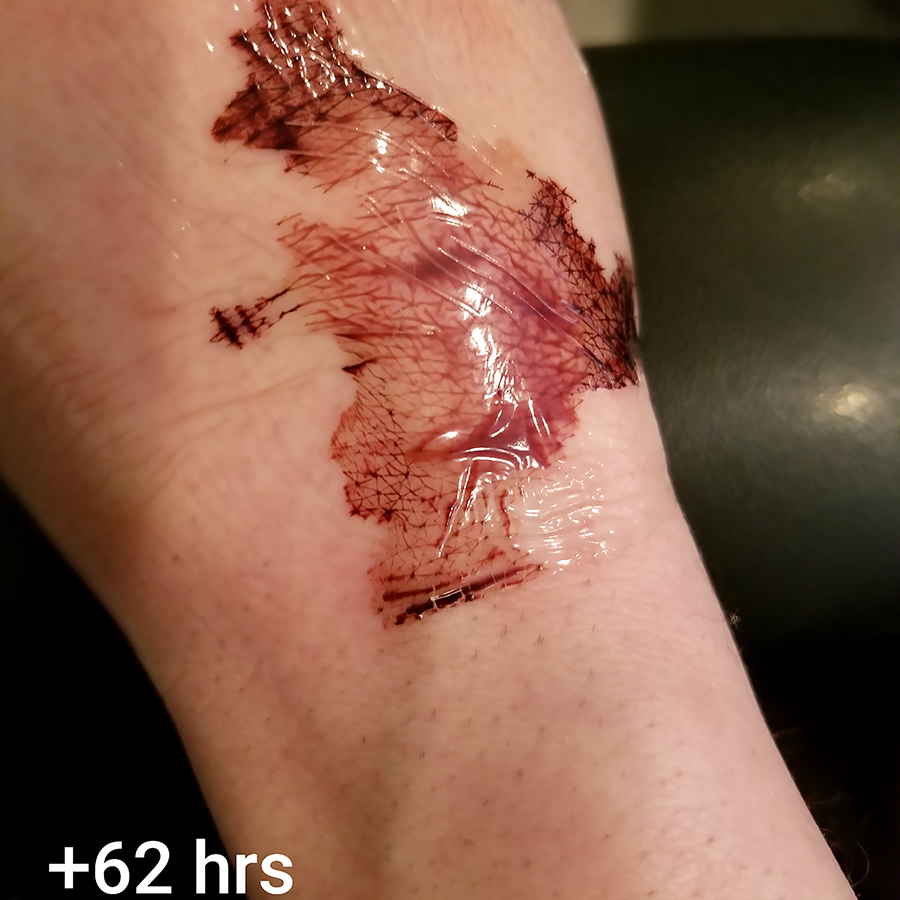 I then removed the bandages as the skin needed to breathe. At this point the wound was closed, but the scab was not solid; it was a soft and almost gelatinous texture. I carefully separated this from the bandaging using a sterilized needle.
I then removed the bandages as the skin needed to breathe. At this point the wound was closed, but the scab was not solid; it was a soft and almost gelatinous texture. I carefully separated this from the bandaging using a sterilized needle.
From this day onwards I had a simple Band-aid over the scab. I took photos at several stages of recovery throughout the process. These can be found in the gallery below.
Tesla recently lowered the power of their NFC readers within the cars, which makes reading the Teslaflex rather difficult; if the Teslaflex isn’t right up against the readers it does not react. For this reason, I was not able to test the product before inserting it and wasn’t able to get a read for 9 days after the procedure.
I took photos for reference, showing the angles I needed to hold the tag in order for the car to register it – you can find these in the gallery below. It was rather exciting when I was first able to get the tag read in the car. It was the end of a good 5 days of trying, which was a huge relief. Video of me unlocking my Model 3 (this was on day 9 of recovery, I still haven’t got the hang of it and swelling hasn’t gone down all the way):

